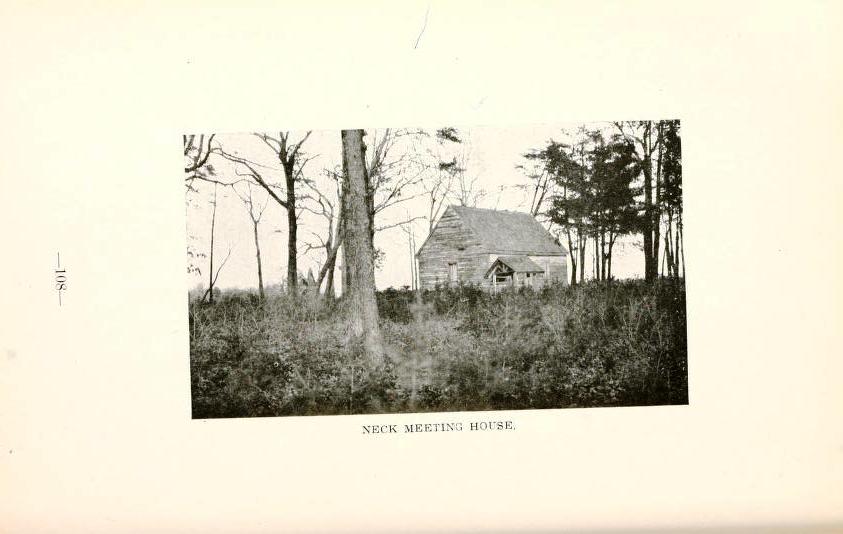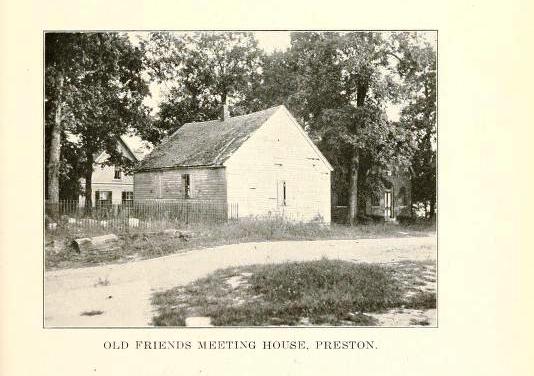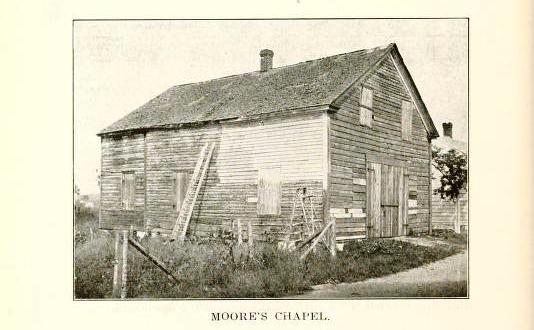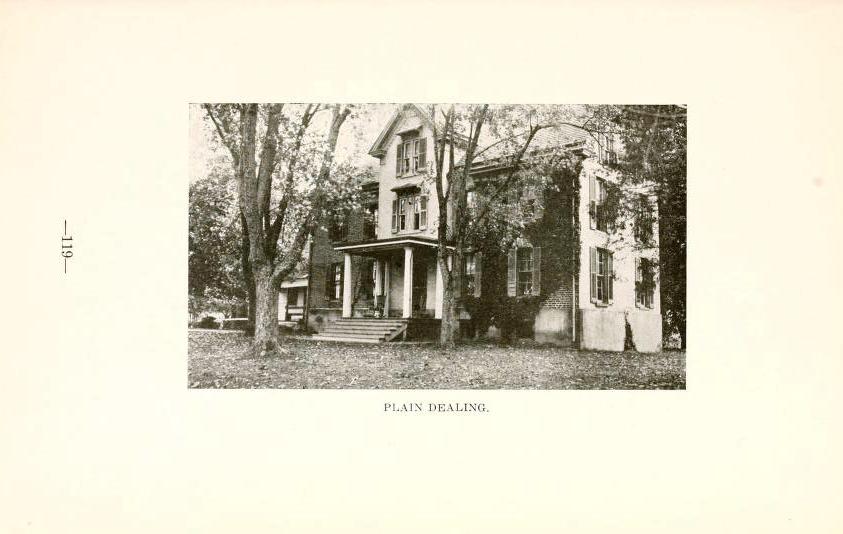The History of Caroline County, Maryland, From Its Beginning
Early Churches and Societies
THE EPISCOPAL CHURCH
A large majority of the early settlers of the Eastern Shore came from
England and as a natural consequence the Episcopal Church, being the
Established Church of England, seems to have been at one time the
strongest denomination along the shore. Parishes were laid out,
chapels erected, and clergy brought from England. Upon the
outbreak of the Revolution, however, these men who were bound by oath
“to be loyal and bear allegiance to the government of England,” were
forced to take the oath required by loyal colonists of Maryland or
return to England. As most of them preferred the latter course,
the churches and parishes were abandoned. Feeling ran so high in
those days that the English church suffered neglect even at the hands of
their vestries.
Another reason for the decline of
power was the opposition to the “forty pound tax.”
This was a poll tax of 40 pounds of tobacco for the support of the
clergy, in addition to such general taxes as were necessary for building
and repairs of chapels. It was levied, irrespective of creed, for
the Established Church. The Declaration of Rights, adopted 1776,
forbade all further assessments for the support of the minister, but
gave the legislature power to impose a common tax for the support of
Christian religion in general. Everyone paying this tax was given
the right to designate the denomination to which his tax should be
credited. So bitter had the people become in regard to the idea of
a church tax that they greatly favored the Methodist societies who made
no mention of a tax and whose minister received the very humble salary
of sixty dollars a year.
ST. JOHN’S PARISH
The Act of Assembly establishing St. John’s Parish was passed in 1748.
After outliving the territory taken in Queen Anne’s and Talbot Counties
and originally held by St. Paul’s and St. Luke’s Parishes the line
extended into what is now Caroline County and apparently included about
all of the county west of the Choptank River.
At this time the parish church was
standing in Queen Anne’s County near Tuckahoe Bridge (now Hillsboro).
This church was evidently built considerably earlier, as a record in
1717 stated that 1100 lbs. of tobacco was paid to Thos.
Fisher for repairing the said church. In 1737 the
edifice seems to have been again repaired and at this time enlarged. Rev.
Mr. Cox, who appears to have been the first rector of St. John’s
Parish, remained until 1753.
Shortly before the Revolution the
three settlements at Tuckahoe Bridge (Hillsboro), Choptank Bridge
(Greensboro) and Nine Bridges (Bridgetown), seem to have been quite
thriving and apparently contended for the honor and advantage of having
the main church and vestry house in which the rector was to live.
The Vestry decided in 1767, as a compromise apparently, that the parish
church should be built on the road from Tuckahoe Bridge to Choptank
Bridge, and that a chapel should be built at Nine Bridges. Two
acres of land for a church site was purchased from Edward
Barwick for 10 pounds ($50) at or near the present site
of Ridgely. This site, however, was not used and the land was
subsequently offered for sale.
The Assembly of 1768 authorized the
erection of the main church at Tuckahoe Bridge and the chapel at Nine
Bridges. Thomas Hardcastle, of Castle Hall,
probably built the church at Bridgetown, as he received several payments
from the vestry at various times. The bricks used in the building
of this church were brought up the river to Choptank Bridge as well as
1600 bushels of oyster shells used in furnishing lime and mortar. John
McConigal agreed to build the brick chapel and parish
house at Tuckahoe Bridge for L1075. At this time Rev.
Thomas Aiken was rector of both churches.
About 1820 a visiting clergyman
reported that the church both at Tuckahoe Bridge and Nine Bridges had
fallen into bad repair and the congregations greatly lessened owing to
the influence of Methodism.
Rev. Robert Goldsborough in
1844 settled in Hillsboro and held services in the Academy there as well
as at Bridgetown. Six years later he was elected permanent rector
and in 1853 the corner stone of the present church in Hillsboro was laid
by Bishop Whitehead of Illinois. The building
was blown down in December following, but work was soon re-commenced and
the church consecrated in 1858.
Rev. G. F. Beaven took charge
of the parish in 1857, succeeding Rev. Mr. Goldsborough.
At this time the rector reported that the church at Greensboro had a
good sized congregation. From a bequest of about $1000 by Mary
Reed, the present church at Greensboro was completed in 1875.
ST. MARY’S WHITE CHAPEL PARISH
The population of Dorchester County having increased and expanded, it
became necessary in 1725 to divide the Great Choptank Parish which
included territory now belonging to Caroline. A new parish was
formed, known as St. Mary’s White Chapel Parish. It included,
beside a small part of Dorchester, all of what is now Caroline County,
east of the Choptank.
Thirty years later the Assembly
authorized the erection of a chapel in the parish. In the
meanwhile, no doubt, services had been held within the parish, but this
was the first consecrated building. The site selected was on the
county road that now leads from Federalsburg to Hunting Creek, about two
miles from Linchester.
The chapel was used for church
services until 1776 when it, like other such chapels, was abandoned by
clergy and vestry. Unused for many years, about 1812 the building
was torn down and the material divided among people of the community. Benjamin and Henry
Nichols, who assisted in razing the building, took as their share
some of the bricks which may still be seen in a chimney of the house
owned by the late Jasper Nichols, near Hynson.
Part of the lot where the chapel stood was used as a burying ground and
has been known for the last century as “Church Old-Field.” A
broken marble slab, bearing the name of Sarah Haskins,
is all the remains of this once sacred land.

QUAKER SOCIETIES
A religious society known as Quakers, or Friends, was established in
England in 1647. Later, because of persecution, many of their
followers, forced to seek new homes, came to America. Maryland had
been settled in the meanwhile to provide a refuge for the religiously
oppressed of the Old World, and naturally received a large share of
these wanderers. They were a quiet but substantial people avoiding
all forms of display and living simple, peaceful lives.
The Friends did not claim to be a
church but rather a “religious society.” They employed no minister
but allowed members the privilege of speaking in their meetings when
moved by the Spirit to do so. There were leaders in the Society
who traveled about on horseback visiting the various meetings, but there
was no salary attached to such services. The government of the
Society of Friends consisted of a center meeting to which preparatory
meetings reported monthly. The center meeting was required to
report to the quarterly meeting who in turn made its reports to a yearly
meeting. These reports, which consist of marriage records,
settlement of the estates of minors, accounts of monies collected, and
other such matters, have been preserved and contain much interesting and
valuable information.
Caroline County, in its early days,
sent reports from its preparatory meetings to Third Haven Monthly
Meeting at Easton. As the societies grew in strength, however, a
monthly meeting was established at North West Fork, with preparatory
meetings at Marsh Creek and Greensboro.
In 1797 the Nicholite Friends (so
called because they were followers of Joseph Nichols)
located in Caroline County, Maryland. After existing as a separate
society for twenty years, finding that the vital and fundamental
principles of their society were similar to that of the Friends,
concluded that a union might prove of mutual advantage, therefore
applied, and were accepted as members of Third Haven Meeting.
Their rigid rules of discipline,
especially in dress, being very objectionable to their young people,
made them anxious for a little more liberty – one of their points of
self-denial being in regard to wearing dyed garments, and cultivating
bright colored flowers. Prior to the dissolution of their society,
they generously transferred to this meeting (Third Haven) their three
meeting houses in Caroline County, namely: Centre (near Preston),
Tuckahoe Neck (near Denton) and Northwest Fork (now Pine Grove).
About four hundred persons became incorporated with the society, though
some afterwards emigrated to Canada and the Western States. Among
those who remained here were Elisha Dawson, Elizabeth
Twiford, and James Harris, all ministers in much
esteem. Dennis Kelley and family, Levin
Pool and family, John Wright and
family, Preston Godwin and family, Samuel
Emerson and family, Wm. Maloney and
family, Willis Charles and family, Jonathan
Shannahan and family, and Anthony
Whitely, were some of the most prominent members who connected
themselves with this meeting.
FRIENDS
The Quakers of Talbot County established in 1676 the Third Haven Monthly Meeting at Easton. This was the center to which preparatory meetings throughout Talbot and Dorchester later made reports at regular intervals. One of the earliest of these meetings was held at Marshy Creek previous to the formation of Caroline County. Later the meetings at Greensboro and North West Fork were established under Third Haven, but in 1799, North West Fork becoming a monthly meeting, both Marshy Creek and Greensboro reported there.
MARSHY CREEK MEETING
Among the records of the Third Haven Monthly Meeting in Easton we find
in 1727 an account of Marshy Creek Meetings being held regularly, but we
do not find the date of their organization. Thirty years later
Third Haven ordered "the several weekly meetings to proceed to a
collection to raise money to assist friends at Marshy Creek Meeting in
the building of a new meeting house and to make a return of their
subscriptions to the next monthly meeting." This indicates that
there had been a meeting house there previous to that time, but we find
no other record of its existence. The house, built with the money
thus collected, was a small frame building, plainly furnished, with a
sliding partition which separated the men and women during business
meetings. It was erected on a half acre lot deeded in 1764 by William
Haskins to William Edmondson near
the present site of Preston and used by the Friends until 1849.
At that time James
Dixon deeded to the Trustees of the Society of Friends
a piece of land located in what is now Preston for the small sum of $5.
The meeting house built on this site is still standing and was used
until the erection recently of a more modern brick structure adjoining
it. When the land was purchased at Preston we find records of the
old building and land at Marshy Creek being sold to the colored people
for $100. The building was used by them as a Methodist Church
until a few years ago when a new church was erected on the old site.

NORTH WEST FORK MEETING
Levin Wright and Mark Noble of North West Fork asked permission in 1794 to hold Quaker meetings in their homes. This resulted in the organization of a preparatory meeting which in 1799 occupied the building previously used by the Nicholites at Federalsburg. In the same year a monthly meeting was established there with preparatory meetings at Marsh Creek and Greensboro. In later years the meeting house was moved to Piney Grove, about two miles west of Federalsburg and enlarged to accommodate the increased attendance.
GREENSBORO FRIENDS
In 1795 the second Friend's Meeting House in Caroline County was completed at Greensboro. The house stood on a half acre of land deeded by Batcheldor Chance to Thomas Hopkins and Edward Needles for L5. Part of the land was to be used as a Quaker burying ground and a few of the old stones may still be seen on the west side of Main Street between the homes of Dr. Malone and Mr. Fred P. Roe.
A VOICE FROM NECK MEETING HOUSE
Long have I stood and am now very old,
Some of my tales I never have told,
But here are some that you shall hear,
Since you are so anxious, my dear, my dear.On long past Sundays, Friends here would meets,
And each sit solemnly in his seat,
Then during the war soldiers came here to stay,
Once I was school, and my grounds used for play.Wonderful changes have I seen,
Sometimes I wonder what they can mean,
One day I was startled most sadly, Ah me!
By what men call a train on the M.D. & V.Now the horseless carriage goes riding by,
And only last Sunday I saw one in the sky,
No wonder you children come here to see me
And write me down as history.
THE NECK MEETING HOUSE
About a mile from Denton, on the Hillsboro road stands the Neck Meeting
House, a quaint old wooden structure of a century ago. A dense
growth of underbrush almost obscures the building from public view and a
substantial wire fence protects it from curious prowlers. The
building, long ago robbed of its benches, library and other simple
furnishings, is slowly crumbling to decay.
In the year 1801, Quakers living near
Denton who had formerly belonged to the Nicholite Friends, asked Third
Haven Meeting for the privilege of holding preparatory meetings and
building a meeting house. This request was granted and in the next
year, the situation having been selected and plans for the building
completed, it was found that $60 was needed beyond what could be
supplied by the Neck Meeting. This amount was raised by other
Friends and on September 26, 1802, the first service was held in the new
building. The land (11/2 acres) was deeded
by William Wilson to Tristram
Needles, and other trustees, for the use of the Society of Friends
in consideration of L4, 10s.
Besides being used as a meeting
house, Eliza Heacock of Philadelphia
held private school there about 1856. Her splendid teaching
ability and sterling character built up a strong private school.
Another well-known teacher of the school was Miss Rachel
B. Satterthwaite, of Denton.
Previous to the Civil War
abolitionist meetings with speakers of national fame are said to have
been held in the meeting house. During the war, Northern troops
used the grounds for a camping place and the house for barracks.
The blue coats, worn and tired, would politely withdraw on Sunday
morning in order that the Friends might hold their meetings unmolested
and some are said to have returned at times to attend the services.
About 1890, for lack of funds, Neck
Meeting House was abandoned as a place of worship. To protect the
spot where his parents lie buried, Edward Tylor, a
half-brother of Miss Satterthwaite,
secured legislative enactment to purchase the land about the meeting
house and further protected the grounds by erection of a substantial
iron grating.
In a poem of Miss Satterthwaite's she
thus pays a final tribute to the meeting house:
(Written from material collected by Denton School.)"And a sheltering place for the birds of the air
May this house become, where once echoed prayer,
But the Spirit of God is above heat and frost
And the echoes of prayer can never be lost.
The life of a Christian for ages may gleam,
Though his sect cannot wear Christ's coat without seam."
THE NICHOLITES
A very pious religious sect known as the Nicholite Friends had in the latter part of the eighteenth century quite a stronghold in that section of our county bordering on the upper Northwest Fork River and Marshy Hope Creek. The Nicholites first permanent place of public worship was in a meeting house erected on the banks of what is still known as Quaker Meeting House Branch, near the site of the old colored school at Federalsburg. About 1817, the Nicholites were accepted as members of the Third Haven Meeting and generously transferred to this meeting their three meeting houses in Caroline, namely: Centre (near Preston), Tuckahoe Neck (near Denton) and Northwest Fork (now Pine Grove).
THE METHODIST CHURCH
As early as 1771 we find evidence of the teachings of John
Wesley having penetrated to the Eastern Shore of
Maryland. Freeborn Garretson, of Kent Circuit,
seems to have been the first organizer of the Methodist societies in
Caroline, having visited here about 1776. Later, Jesse
Lee and James Moore rode
the circuit in tireless efforts preaching and organizing new societies. Francis
Asbury, the greatest Methodist itinerant, in his trips from
Massachusetts to Georgia, frequently stopped at the homes of Captain
Frazier, Major Mitchell and Henry
Downes, all of this county.
Referring to Asbury and
other Methodist circuit riders, Scharf says:
"The people used to ill-read services and dull-written sermons flocked to hear these marvelous preachers who prayed without book and preached without manuscript; who went on horseback to the people instead of waiting for these to come to them; who lived on $60 a year, and never said a word about advowsons and forty per poll, about personal livings and fat glebes."Extracts from Asbury's journal (1789-1813) prove his enthusiasm and tireless energy. A few which mention his visits to Caroline are given here:
|
|
The first Methodist church in Denton was named for James Moore, of whom Asbury writes in his journal, and was known for many years as Moore's Chapel.
The first Methodist chapels in the county were the outgrowth of meetings held in private homes. They were located at Tuckahoe Bridge (Hillsboro), Choptank Bridge (Greensboro) and near the present site of Preston. These buildings, simple in design were rudely but substantially constructed by members of the various societies. The present Methodist Episcopal Churches at these places are results of these chapel meetings.

MOORE'S CHAPEL
An interesting story is told of the origin of the Methodist Episcopal
Church in Denton, but how authentic it may be we cannot say. A
traveling minister nearing the town on horseback decided to pass through
the place singing and if invited to stop would take it as a sign that he
should organize a meeting there. He carried out his plan and soon
after entering the village was asked to alight. This he did, and
true to his purpose, organized the first Methodist society in Denton.
Moore's Chapel, previously referred
to, was the first church ever built in Denton. It stood on the
site of the Methodist burying ground behind the present M. E. church.
In this building on March 24, 1816, James Moore, for
whom the chapel was named, preached the first Methodist sermon ever
preached in the town.
The entrance to the chapel was
through a vestibule, from which a stairway led to the gallery.
This gallery was for the use of slaves, for at that time the colored
people had no church of their own, but attended the same services as
their master when permitted. After service they would sometimes
sing as the white congregation passed out. The interior of this
church, as all others of that time, was quite different from those of
the present. Carpet was not used except on the floor of the pulpit
and a runner up each aisle. The desk was narrow and so tall as to
reach almost to the preacher's chin. The pews, narrow and
straight, were uncomfortable enough to keep even the sleepiest listener
awake.
In 1867 Moore's Chapel was moved and
the present brick church built. The old chapel may still be seen,
almost in ruins, on North Third Street, where for a long while it was
used by the colored people as a church and later as their hall.
(Material contributed by Denton School.)
CONCORD CHURCH
In 1804 John Mitchell, Isaac Collins, Sr., Horatio Short, Francis and James Sullivan were trustees of the society then meeting at the home of Abraham Collins. These men, with the approval of the minister in charge, purchased from Mr. Collins 11/20 acres of land for a meeting house site. The chapel was to be known as "Concord" and from that time on the cross roads, too, have been called by the same name, apparently the only one ever given it. Twenty-five years later a permanent building was erected and the old chapel passed out of existence as such, so far as it is known.
LEE'S CHAPEL
A barn on the farm of Mr. Freeborn Elwanger near
Whitelysburg has an interesting history. In the latter part of the
18th century people living in that section by the name of Lee were
instrumental in building a chapel on their land. The chapel was a
small wooden building with hewn framework put together by means of
wooden pegs. The few nails used were made by the village
blacksmith. The chapel was named for the Lee family
and sometime during its existence as a church a member of that family
served as a minister. With the growth of the neighborhood,
Shepherd's Chapel succeeded the original one which was moved to its
present site and converted into a barn.
(From material contributed by Lowe's School.)
ST. ELIZABETH'S CATHOLIC CHURCH (DENTON)
Incomplete records show that previous to the organization of Caroline as
a county, a Catholic mission existed in the vicinity of Denton. In
the absence of a regular church building it is probable that services
were held in private homes. From Bohemia Manor in Cecil and St.
Joseph's Chapel in Talbot, Jesuit fathers came to serve the mission.
Probably one of the earliest of these priests was Rev.
Joseph Mosley, who served Old St. Joseph in 1787.
In 1824 Benjamin
Denny deeded to Ambrose Marshall,
then Bishop of Maryland, an acre of land which was part of the tract
known as Mt. Andrew. It was on this lot that the first Catholic
church was erected, a little to the north of the present building.
The date of the erection of the church is not known. In Capt.
William Richardson's will, dated 1831, four prints and the bust of Arch
Bishop Carroll were ordered removed to the Catholic
Church at Denton, there to be disposed of by the priest. This
clearly indicates the erection of the building some time previous to
that date. Residents of Denton remember the building as being a
rather pretentious one containing various pieces of imagery, busts and
pictures, but bearing marks of old age. In 1890 when the present
church was erected, the old building was torn down and some of its
splendid white pine probably used in the new building.
In 1845 Anastatia
Rhodes of this county very generously willed to Samuel
Eccleston, the Archbishop of Baltimore, her splendid farm situated
on the road between Denton and Williston. He was to dispose of the
land "as best to promote the cause of the Holy Catholic religion in
Caroline County especially for the support and good of the Catholic
church in Denton." The place, which is still known as the
"Catholic Farm," was not sold until 1867 when its sale brought the sum
of $2500.
